BasSmart: Part 2
Where Bass Live and Eat
In Part 1 we talked primarily about Largemouth Bass behaviour. Now we are going to drill deep into their habitat and the locations—basically, everything you need to know to track down Mr. LMB.
Good Weeds
Green weeds emit oxygen, which in turn promotes new life in the form of microscopic organisms like Zooplankton and Phytoplankton. These tiny life forms attract insects, frogs, minnows, and other small creatures that feed on them. This is a scenario that makes bass incredibly happy: lots of food, good protection from other predators, and great ambush points. However, Largemouth Bass prefer some types of weed to others; knowing what they are is vital. Cabbage (Potamogeton spp.), Coontail (Ceratophyllum demersum), and Milfoil (Myriophyllum sibiricum) are the three most preferred—but broad-leaf cabbage is the number one choice, by far.
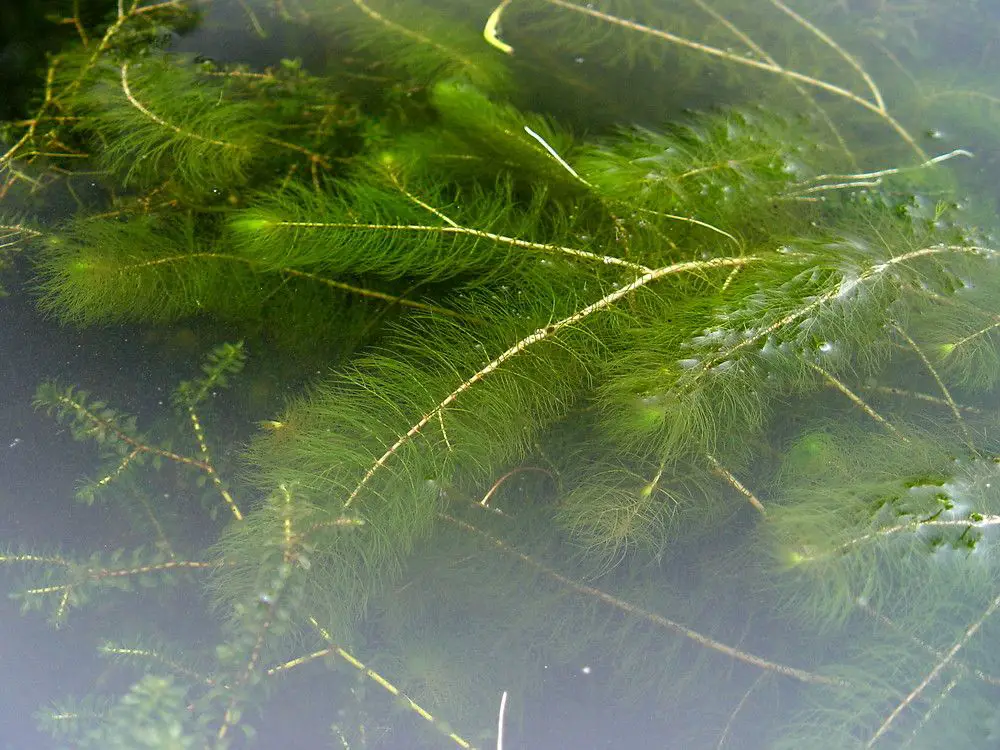


Cabbage (or Pond Weed, as it is sometimes called) is a fish magnet. It provides the best possible bass-holding habitat due to several factors. First and foremost, it attracts all types of panfish because it houses snails, small invertebrates and crustaceans that feed on the underside of its leaves; so much so that wherever they are prevalent, bluegills nest exclusively around the base of the weeds, making it a veritable smorgasbord for most predators in the area— bass included. This hardy plant is not necessarily the deepest growing weed in its environment (it will grow as deep as 20 feet), but it often prefers to grow near drop-offs and along deep tapering points. In other words, it lives where the bass live: on or near the bass highway, contact points.
Another interesting characteristic that cabbage has is that it is often the first plant to emerge after ice out and the last plant to die off in late fall, meaning that cabbage beds produce oxygen long before and after all other plants are gone for the season. This becomes a key factor in establishing the bass migratory path in your favourite body of water because—although you may not necessarily be fishing them when they are spawning—the existence of cabbage beds along good bass contact points will help determine their migratory highway from deep water wintering areas to shallow spawning bays. I’ll guarantee you that primary summer homes will be somewhere in between. Find it and you, my friends, will be in bass heaven.
Bad Weeds
Brown or rotting vegetation, no matter what variety, depletes oxygen from the immediate area and replaces it with carbon dioxide, thus lowering PH levels. And nothing says “Hit the road, Jack” to bass louder than lack of oxygen and low PH. In all cases, these conditions will cause bass to move to more tolerable areas. Look at it this way, if the oxygen levels start to deplete in your home, the very first thing you’re going to do is get away from there and seek fresh, breathable air. Bass are no different.
Very sparse weeds or weed-choked areas are generally not ideal bass habitat and will be used only as a means of getting to and from preferred contact points. So don’t spend too much of your valuable fishing time in these areas.
Break-Lines
A break-line is simply a change in bottom contour or composition. A rock drop-off or weed-line (end of a growth of weeds) is often inhabited by bass. They’ll relate to weed edges and drop-offs the same way they would relate to a shoreline. For example, cabbage weed is often found on mid-lake humps and flats, but the water surrounding this vegetation is deeper and thus penetrates the deeper areas. Largemouth Bass often hide along the edges of these weeds and ambush prey that moves by. They’ll often bury themselves deep into cabbage on hot days or suspend over deeper water during seasonal changes.
This mid-lake structure of cabbage weeds attracts a multitude of game fish species because it provides deep-water access. Largemouth follow shorelines like a highway until they find a suitable environment. Weed-lines and break-lines, likewise, are also followed until the bass finds suitable cover. Find out where the bass are hiding, and you’ll be in for the fishing experience of a lifetime.
Overhead Cover
Lily Pads beds act like an umbrella over the water’s surface. This is a perfect place to find marauding bass. But not all pads are created equal. Water Shield (or dollar bonnets, as they are more commonly known) are often mistaken for lily pads. They may look good from your vantage point, but to a smart ol’ bass, they’re way too small and flimsy. They need to support frogs, snakes, birds, and other small animals that use lily pads as hunting areas.
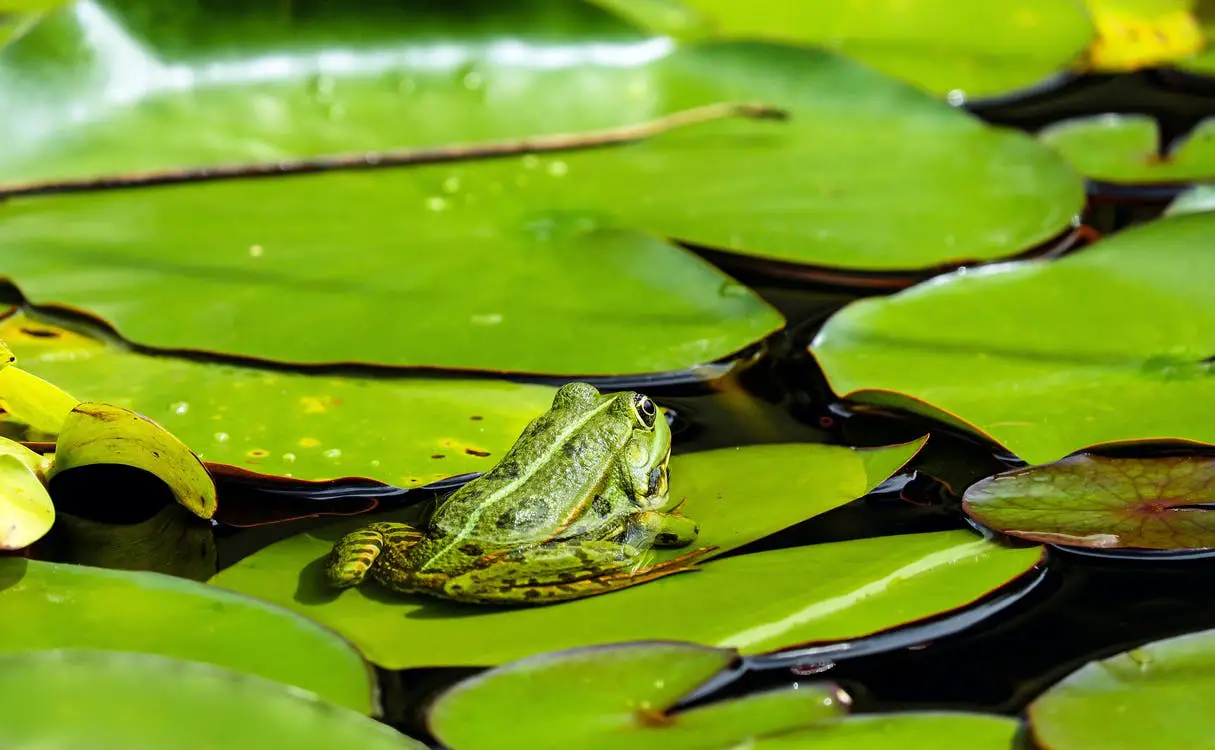
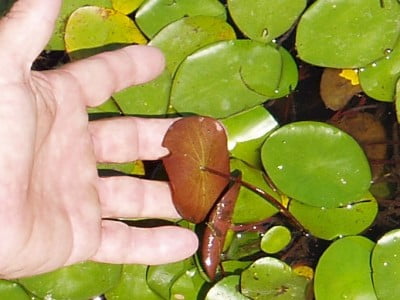
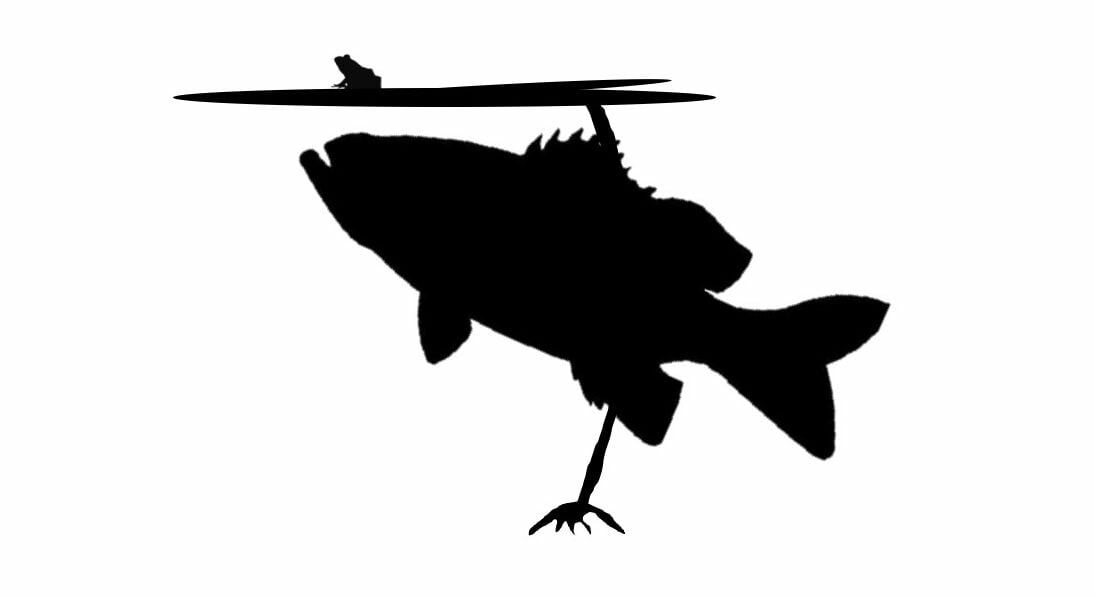
Frogs are the most common bass food in lily pads. They are well camouflaged and stealthily wait for insects to fly into their ambush areas. Bass do the same thing; they rest quietly under lily pads, waiting for prey to fall into their world. One false move by the frog and the bass will often plow right through pads in an attempt to disorient their prey and propel it into open water where it can be easily captured.
But bass that are located in lily pads are not feeding exclusively on topwater creatures; they will readily prey on subsurface life as well, because bass are opportunistic fish.
Lily pads over 2-3 feet of water with adjacent deep-water access will usually yield the most bass. I prefer clear water pads much more than muddy-water ones, but, in all fairness to that comment, I have caught some really nice Largemouth in off-coloured water pads as well. When push comes to shove, and you’re confronted with way too many pads to fish in one day, cherry-pick. First, work the isolated clumps that are closest to deep water and sitting in 2-3 feet of clear to slightly-stained water. Focus on these areas, and you should have some remarkable action.
Arrowheads
These are a triangular weed that possess similar characteristics to lily pads but fish totally different. Arrowheads grow in dense clumps with massive root systems that are home to a multitude of creatures—all of which are on the bass menu of favourite foods. They are common to most marshy areas and should be fished as much as lily pads. Big bass like hunting arrowheads because they offer everything that pads do and more. The dense nature of arrowhead roots offers the ultimate home for lunker bass.
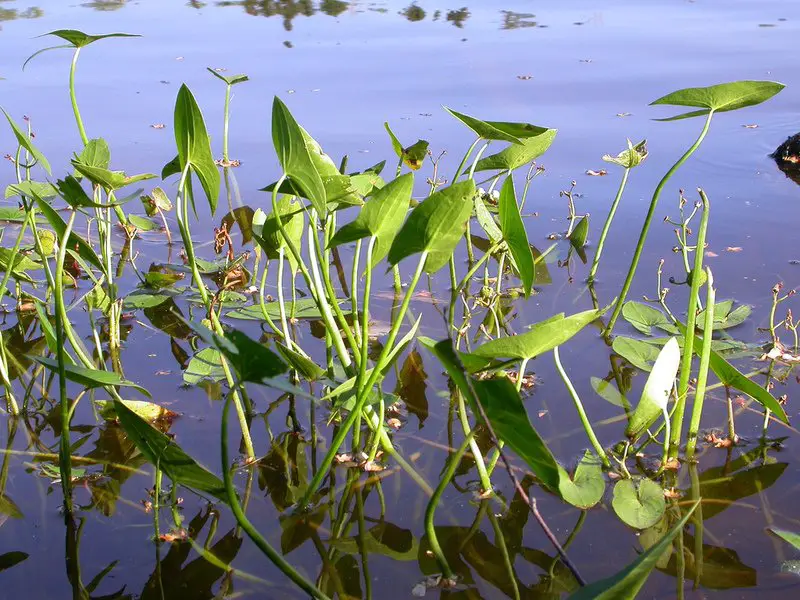
Cane and Rushes
Canes and rushes grow high above the water’s surface. They do not possess the same umbrella quality as pads and arrowheads, but bass like these weed areas and they provide great ambush opportunities and suitable protection for foraging fish. Canes and rushes are usually found in windswept areas and offshore locations. They allow current to pass through easily, unlike pads and arrowheads. This current carries nutrients that become trapped in the cane stalks. Baitfish and other forage gather to feed on these nutrients, and these forage fish attract bass.
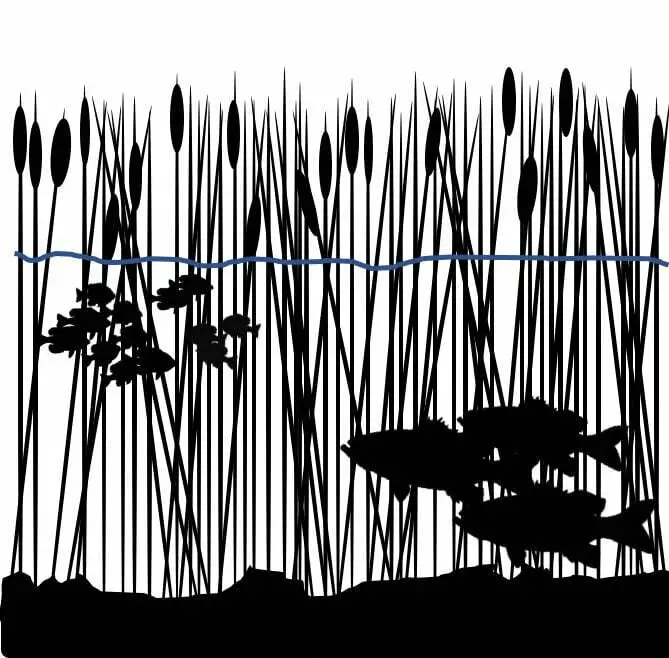
Floating weeds—called a mat—are frequently carried into rushes and canes by wind and current where they become trapped. These are high-percentage areas and can hold monster bass.
Cane and reed growth played a significant role in Pete’s success during this fishing day-trip to Lake Simcoe.
Matted Weeds
Vegetation that loses its rooting for one reason or another is often carried by prevailing winds to specific areas. It will build up on shorelines or in canes and rushes until wind direction changes or extreme water levels free it to float further. This accumulation of surface vegetation is called a mat.
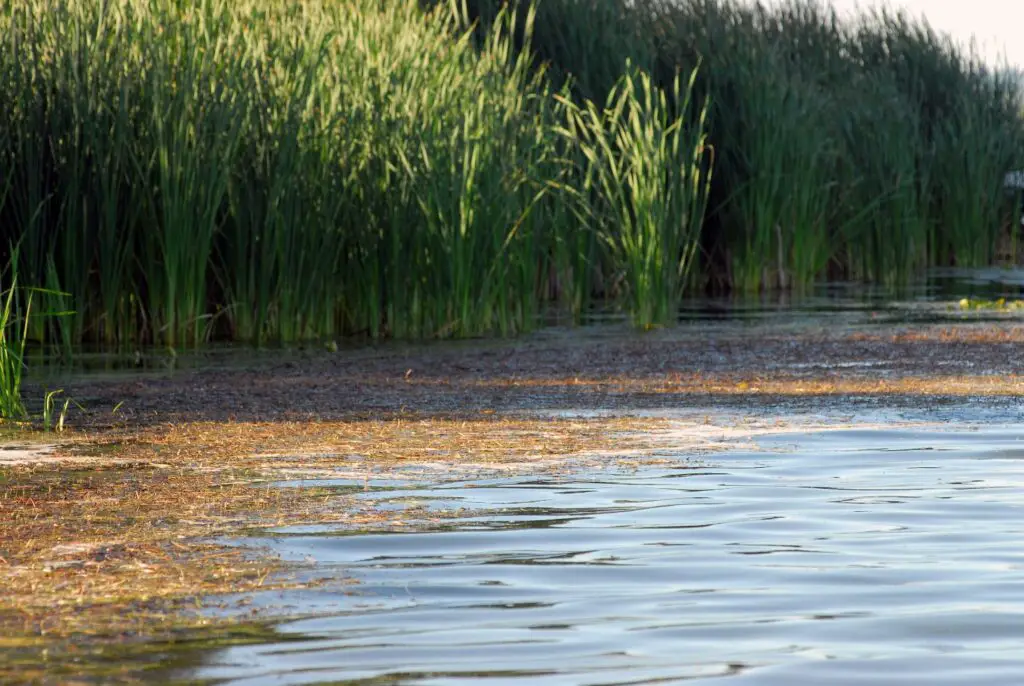
When mat congregates around areas with deep water access and plentiful forage, bass are sure to be under it. Mats provide bass with protection and an excellent ambush area. Some common types of mat are duckweed, algae bloom and slop. Always remember that if there is a hiding place available and deep water access, you’ll be sure to find Largemouth.
Here, the Doc (Gord Pyzer, Outdoor Canada) provides more info about throwing frog-, mice- and rat-style baits on mats during the fall.
Wood
Wood provides bass with protection, food, and comfort. Largemouth often hide in fallen trees, brush and stumps, awaiting their prey. Wood cools more slowly than water. That’s why wood is often a good choice of structure during extreme drops in temperature. Wood, as fish structure, can be found in many different forms: fallen trees, brush, stumps, submerged trees and beaver houses are a few typical wood structures.
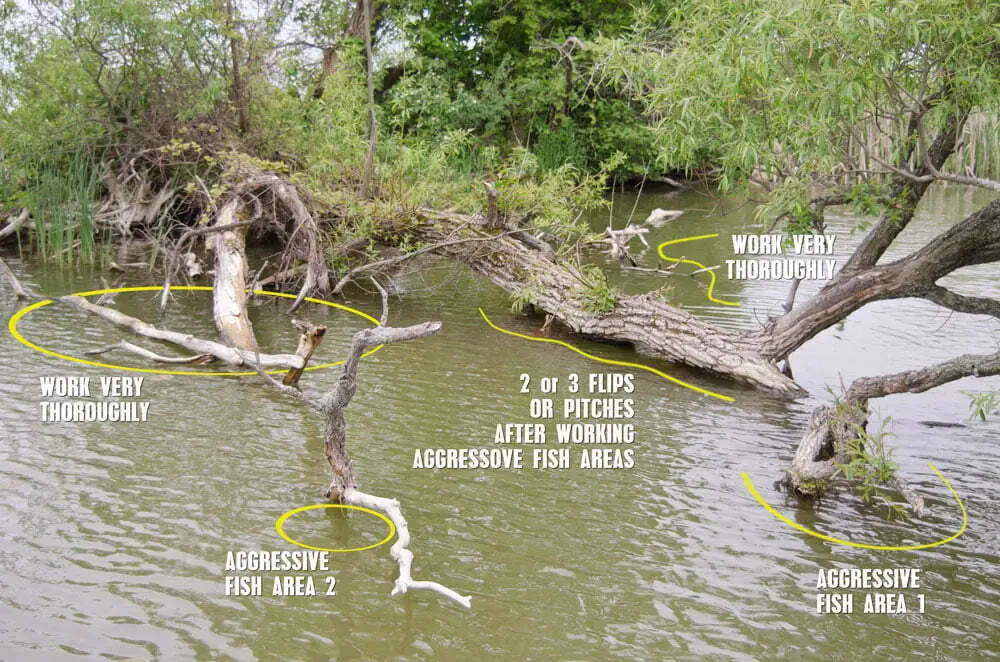
Largemouth inhabit areas like these because they provide them with their three basic needs—food, protection, and ambush opportunities. The heat emission from the wood attracts forage, and the open roots and overhead cover provides protection and a good ambush area. The bottom line is that wood provides bass with a comfortable place to live. Learn to fish fallen trees properly, and your bass catching odds will go up tremendously.
Undercut Banks
Water movement or currents from the flow of rivers or prevailing winds causes erosion. In some cases, this erosion creates an undercut or overhanging bank. These undercuts are characteristics of shorelines with soft bottom and bullrushes growing nearby. This overhanging structure provides Largemouth with a hiding or ambush area.
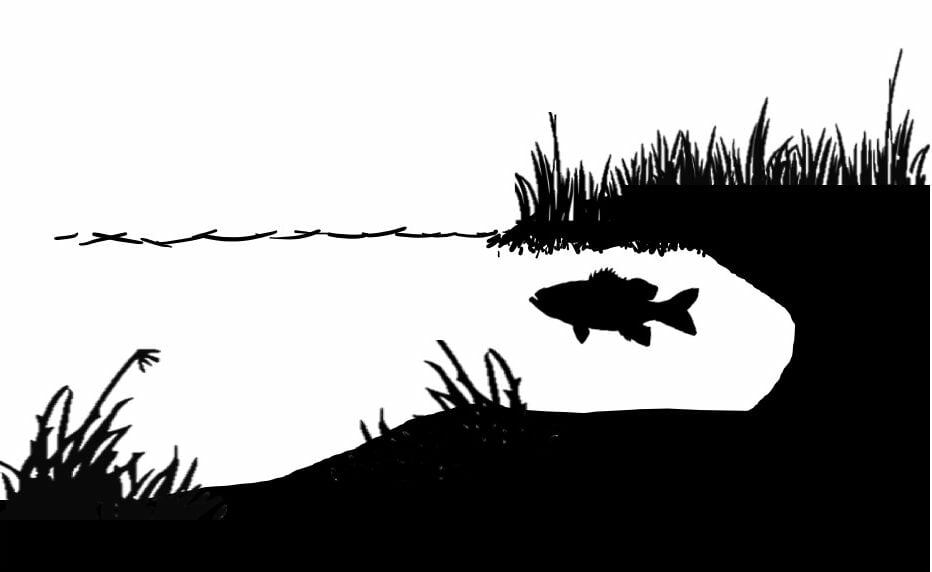
Frogs and snakes often emerge from the shoreline, not suspecting any danger. Many Largemouth Bass live under these banks because of the nearby food source. Bluegills, sunfish, and perch often inhabit these shorelines, so there is no shortage of food. The exposed roots of rushes and trees hold heat, which, in turn, creates a comfortable living environment for bass. If you are looking for real bass action, find an undercut bank with the right conditions present, and you’ll have a memorable day fishing.
Rocks and Boulders
Rocks, gravel, and boulders are usually associated with Smallmouth bass, but Largemouth Bass also relate to these areas simply because they attract suitable forage and deep-water access.
The primary food supply in these areas is crayfish. These small crustaceans provide easy food for bass and are believed to be the most nutritious bass food available.
Rocks carry the same heat-holding qualities as wood, and they are frequently adjacent to deep water. This particular structure has no umbrella-type protection, so deep water close by is particularly important.
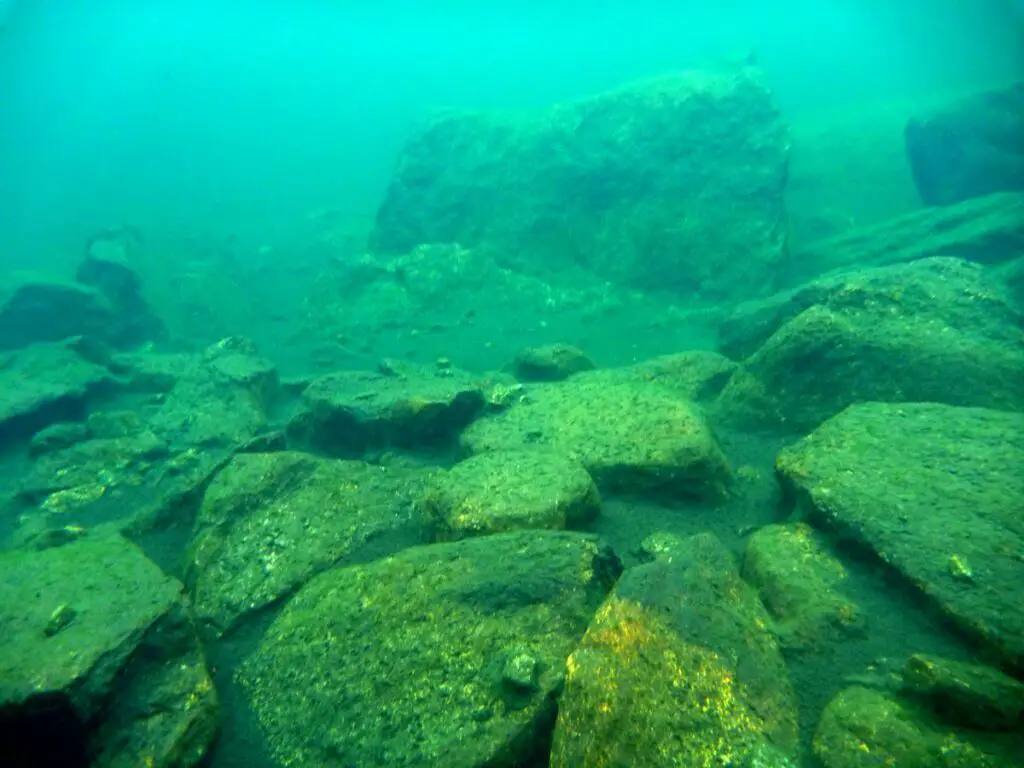
Rocks, gravel and boulders are usually best during morning and evening hours. Crayfish are nocturnal and spend most of their daylight hours hiding beneath rocks. But they go out to feed at night. Since Largemouth are opportunistic, they will also adopt this night feeding pattern. During daylight hours, bass will often retreat to drop-offs where they can find protection.
If there is shoreline structure or cover present, you will find Largemouth Bass hiding there. These fish don’t like to move a long way from feeding areas and will often bury themselves deep into shoreline cover instead of moving to open water.
In Pete’s blog here, he talks about looking for rocks and weeds together.
Docks and Boathouses
The final classification of structure for Largemouth is man-made. Probably the most often overlooked (yet the most productive) structure is often closest at hand. Largemouth aren’t fussy about how their home got there, so long as it’s comfortable and supplies them with food. You’ve probably fished from a dock or a boathouse at one time or another and have found that Bluegills, Rock Bass and Perch always seem abundant in these areas.
While walking on a dock will alarm such fish as bass, it won’t spook unsuspecting panfish, which generally spend a lot of time under docks and have become accustomed to the noise above.
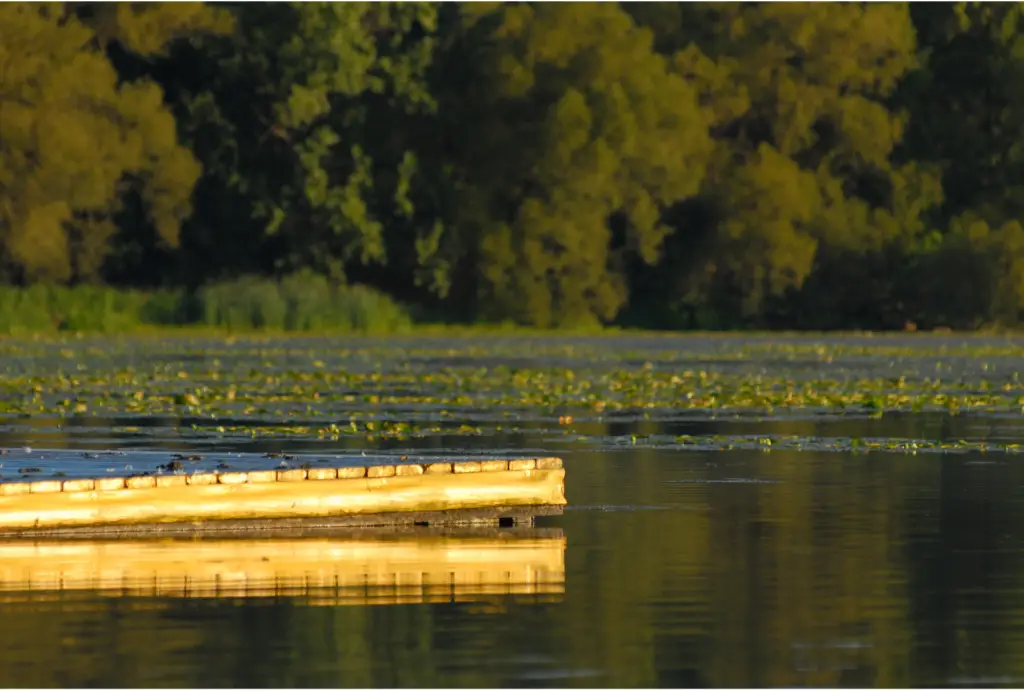
Largemouth will often frequent boathouses and docks in search of food. Since these structures are made of wood, they hold fish, especially during periods of cold weather and seasonal changes.
A dock or boathouse that is good for fishing will have deep-water access and lead-in cover—usually in the form of weeds. The lead-in cover doesn’t have to be directly out from the dock or boathouse; it could be on the adjoining shoreline. Abandoned docks and boathouses will hold bass more often than the ones that get a lot of traffic.
Check out this piece, where the Doc (Gord Pyzer) gives additional info about fishing docks.
Cribs, Pylons and Abutments
These structures are almost always found in current. Current carries nutrients, which, in turn, attract baitfish that larger fish feed on. These structures also provide a shaded, protected environment for Largemouth Bass. Predators can also trap their prey against these structures, making it easier for bass to catch food. Also, abutments and pylon footings usually provide a good living environment for crayfish. A plentiful supply of food will usually mean big fish, and underwater abutments and pylons are no exception.
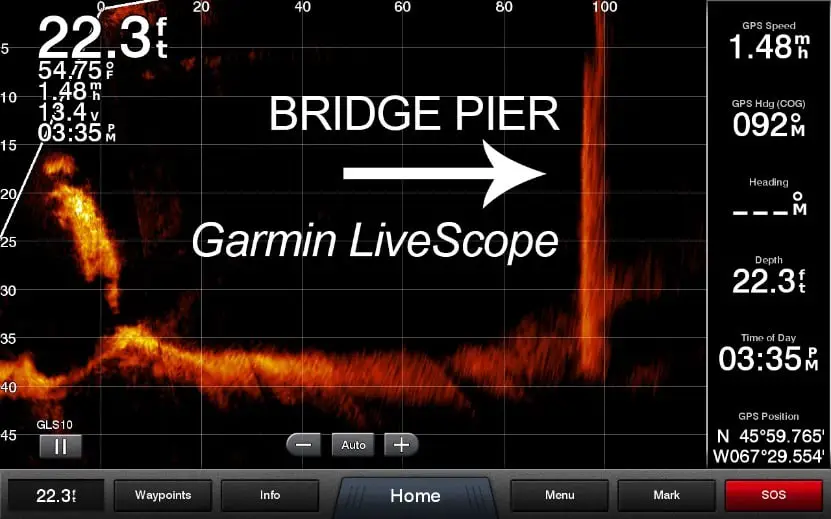
Here’s an interesting piece on bridge piers, captured while shooting a muskie episode on the St. John River in New Brunswick. It doesn’t focus specifically on Largemouth, but the theory is exactly the same.
Riprap
Riprap is simply an area that has been filled in with gravel or rock, usually to make a break-wall. It is commonly around marinas, causeways, and generating stations where break-walls are required to reclaim land. Crayfish take up residence in these rocks, and baitfish relate to them when weed growth is established in the vicinity. Once such an ecosystem evolves, Largemouth will quickly take up residence. Sometimes it takes up to two or three years after construction for riprap to hold Largemouth—but eventually, this will become a productive fishing area.
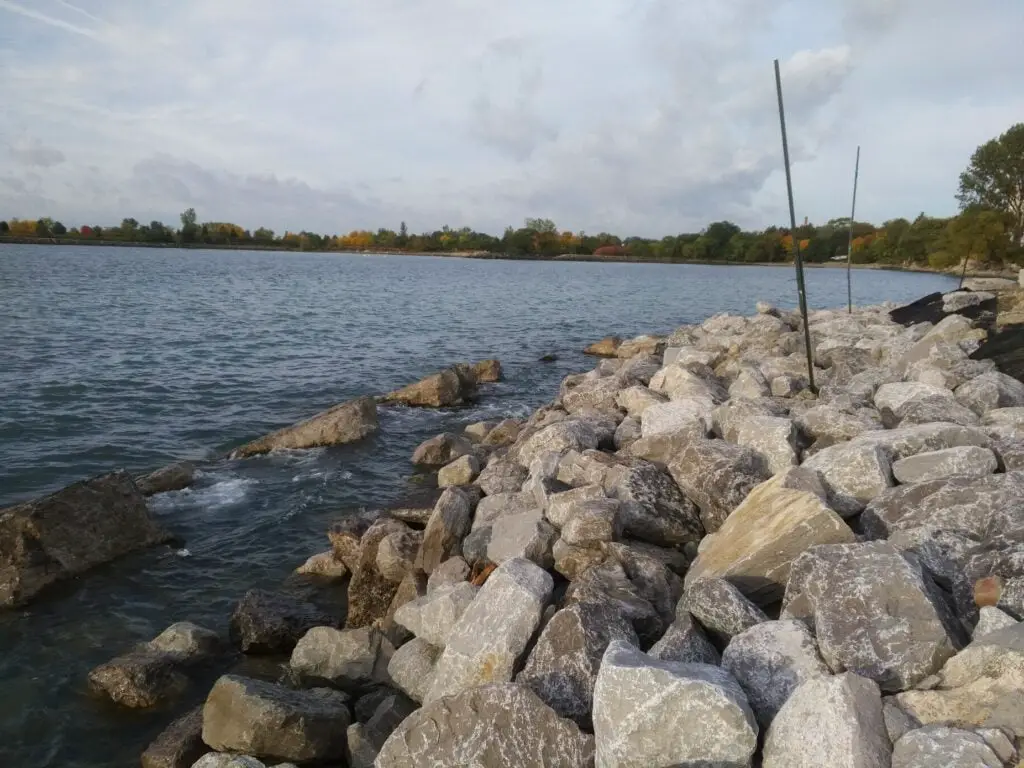
In this Largemouth episode, Pete and Keith Beasley (co-host, Canada In The Rough) had tremendous success in a rock/riprap area of Boundary Dam Reservoir in Saskatchewan.
A Picture is Worth a Thousand Words
If there is any doubt about what was stated in BasSmart: Part 1—that bass have extraordinarily strong habit patterns that enable them to survive in their difficult environment but also make them very predictable and, thus, vulnerable to the savvy bass angler—the following images should lay those doubts to rest. These extraordinary images were originally captured in the early ’80s and have stood the test of time. Everything that we have learned from years of field experience can be summed up by these four little pictures.
The first image depicts a group of baby Largemouth Bass that were placed into a round bowl. The fish are clearly disoriented and scattered.
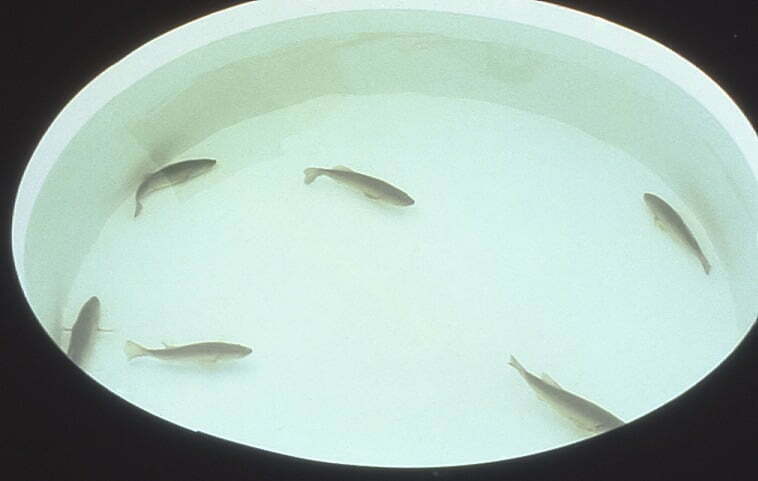
The second image shows the same fish minutes after a handful of gravel was introduced into the bowl. Immediately, the baby bass are drawn to the gravel and start hovering around it. This tiny gravel hump illustrates how important structure is to fish. 100% of the bass in this environment relate to it. Think of this as riprap, rocks, boulders, cribs, pylons, or sunken islands, humps, or points.
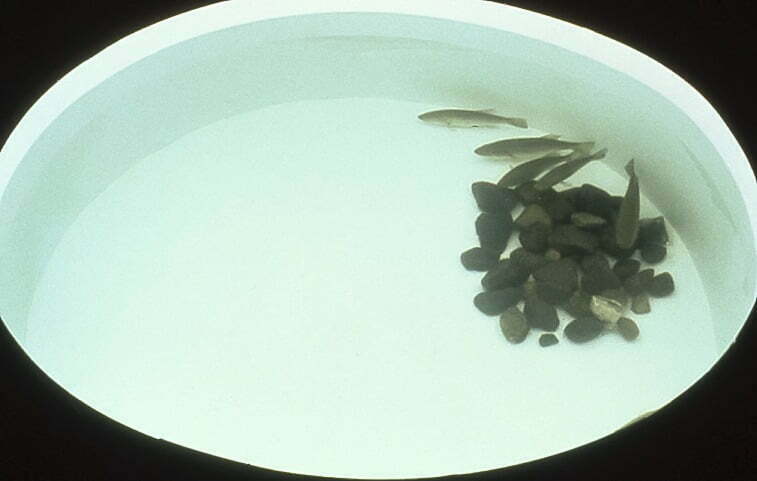
The next image shows what happens when the gravel is removed and overhead cover is introduced. Immediately, the baby bass hide under it. 100% of the fish in this environment preferred to be in the area with cover. Think of this as docks, boathouses, undercut banks, overhanging trees, matted weeds, bridges, etc.
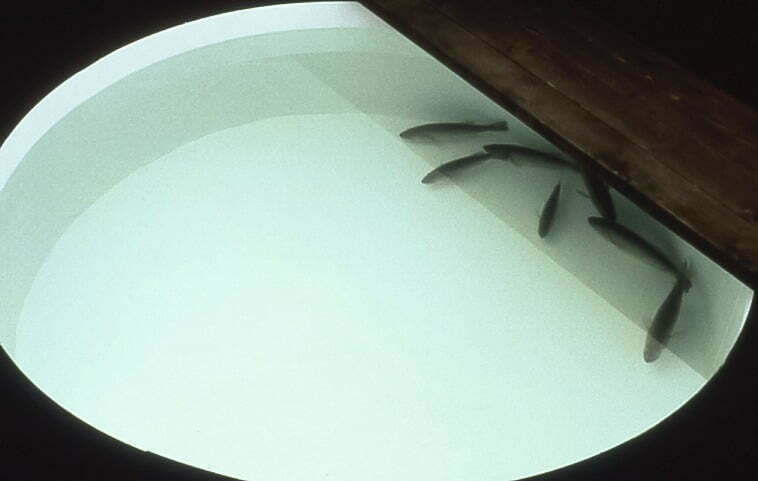
This picture shows a piece of electrician’s tape stuck to the side of the bowl. Remarkably, 100% of the fish immediately used the vertical object as a gathering place. Think of this as the reeds, bullrushes, weed-lines, break-lines, pylons, dock legs—any of the vertical mentioned earlier.
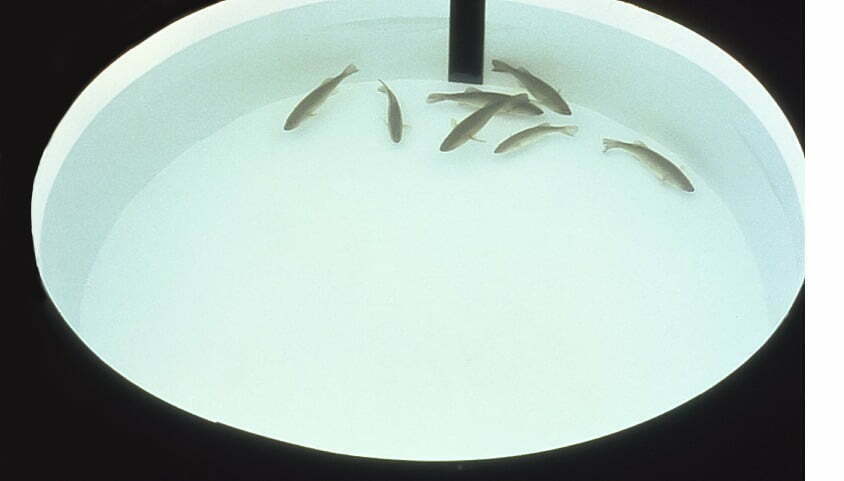
The final piece of this puzzle is baits and presentations; we’ll cover that in Part Three of BasSmart. In the meantime, go back and absorb as much of this part as you can.

This series is fantastic, thank you! I’m learning to fish to teach my own son and all of this info is super helpful. We spend weekend mornings at the lake and all this info is helping me be a better angler so he can be too!
Also, big fan of the podcast as well. Thanks guys!